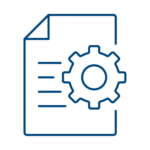Providing employees with a digital workplace plays a major role in a company’s digital transformation. Alongside the necessary technical expertise, it demands a culture change within the organisation. Syntax guides its customers on their journey into a new digital world, supporting them with planning, implementation and day-to-day operations.
Why the digital workplace is so important
The digital era is making new requirements of the working environment with the advent of new models such as remote offices and working from home. While there is no clear definition of what constitutes a digital workplace, there are some fundamental elements common to all modern-day working spaces. A dynamic corporate environment is built around flexibility and mobility. Workers expect simple ways of communicating and collaborating with their colleagues and teams via platforms and services in the cloud, which they want to be able to access anywhere, from any device, at any time. Enterprises that are slow to embrace the digital workplace transformation will quickly lose out in the struggle to retain talent.

Benefits of digital workplace solutions

Flexibility and availability
Every employee has access to their data, files and information around the clock via a central platform, irrespective of their location or device.

Efficient collaboration
A digital workplace lets people work together on documents in real time, effortlessly sharing information and knowledge through integrated digital communications channels.

Security
Comprehensive security features ensure that protected content can only be accessed by authorised users whose identity has been verified in the cloud through secure end points.

Transparency
By making documents and content available through one central repository, all stages of editing and processing carried out by the employees involved in each project can be tracked easily and clearly.

Satisfaction
Simple collaboration and the smooth exchange of information within the digital workplace foster a culture of creative sharing and encourage all employees to be creative in their work.
Syntax Digital Workplace Services
Managed Microsoft 365:
As a Microsoft Gold Partner for Cloud Productivity, we look after the smooth operations of Microsoft 365 as the core platform for the digital workplace.
Modern Collaboration:
In addition to managing the technical implementation, we carry out assessments and lead workshops as part of a well-founded implementation concept that guarantees acceptance among your employees.
Modern Device Management:
We put in place the prerequisites for flexible remote working using all devices, from traditional desktop and laptop computers to mobile and hand-held devices, as well as virtual clients.
Digital Workplace Security:
We develop and implement an integrated, cross-platform security concept to ensure that the cloud-based benefits of the digital workplace do not become a security risk.
Three steps to the digital workplace with Syntax
Syntax guides its customers on a three-step journey to implementing the digital workplace using Microsoft 365:
- Assesment: Our experts analyse your current working processes and the enterprise software you use. By looking at interdependencies between the systems we can determine specific areas of optimisation that a migration to the digital workplace can bring.
- Roadmap: We evaluate our findings in respect of suitable solutions and services available for Microsoft 365. We then develop a bespoke roadmap just for the requirements of the client.
- Migration and Operations: We conduct a detailed, planned migration to Microsoft 365 in coordination with the company’s project staff. And if required we can then ensure ongoing smooth operations of the digital work processes in the new environment.
Talk to our expert!

FAQ: Digital Workplace
What is special about a digital workplace?
When planning and implementing a digital workplace as part of your digital transformation, you need to focus on three key aspects:
- Flexibility and mobility: A digital workplace that provides all solutions and services flexibly through the cloud enables every user to work independently and creatively, wherever they are located, whatever device they are using, and at any time of the day or night.
- Modern collaboration: Using digital applications to work together is a core element of the digital workplace and makes it possible to share information efficiently, with functions such as screen sharing, online meetings and real-time editing of documents and data by multiple users.
- Culture change: To get the most efficient and productive results from the digital workplace, businesses must foster an engaged and open culture that supports modern ways of working. This means providing employees with training in how to use the relevant tools.
What is hybrid work?
Even before the pandemic, there was a clear trend in favour of working online. Employees are looking for the perfect balance between working remotely and spending time in the office. They want to be flexible to decide for themselves which tasks they can do remotely while retaining the option for in-person meetings with the rest of their team when necessary. Combining these two environments is the challenge for the modern digital workplace.